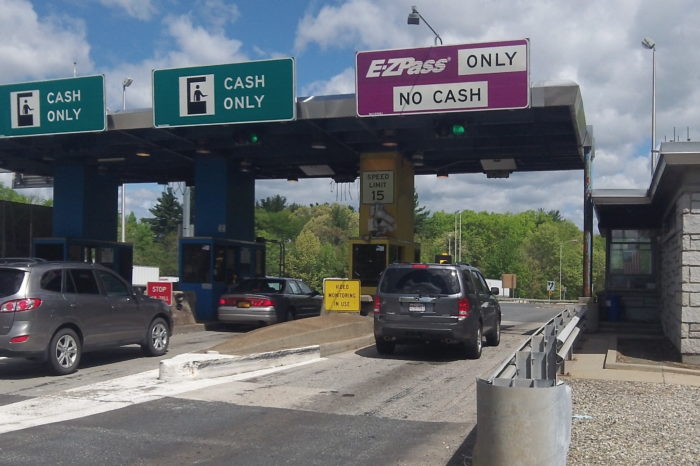A Change in Toll Collection
For more information on Massachusetts’ new tolling system, read the full report.
Starting this fall, the Massachusetts Turnpike will become an open-toll road, meaning drivers will not have to stop or slow down to pay. Sensor arrays distributed along the length of the Turnpike will either read the driver’s E-ZPass transponder, automatically charging their tolling balance, or a picture of the driver’s license plate will be used to send out monthly bills in the Pay-by-Plate (PBP) system.
The state maintains that the primary advantage of an all-electronic tolling system (AETS) is driver safety, emissions and congestion reduction, and general customer convenience. If implemented correctly, switching to an AETS will also save the state millions of dollars.
Under the new system, some toll charges are not assessed until up to a month after the transaction. PBP users must wait for a bill in the mail before paying, as opposed to the current system where each driver is forced to pay the toll while driving. Those who fail to pay their tolls are assessed minor fines after every 30 days, culminating in a possible license suspension after 90.
Despite these penalties, there will be a certain amount of ‘leakage,’ toll revenue that is never collected. So while the state saves money on tolling system operations (no more toll plaza maintenance, toll takers, etc.), the new system is less efficient at collecting tolls.
MassDOT first piloted an AETS on the Tobin Bridge in 2014. A Boston Herald review found that two months into the pilot, 15 percent of total tolling revenue went uncollected. While 15 percent seems high, it is likely inflated due to drivers not understanding or being fully prepared for the new system. Over time, the leakage rate should come down, but it is unlikely that the state will ever collect every toll transaction.
The primary way for the state to reduce leakage is to decrease the number of drivers using the PBP system and process more transactions through lower-maintenance E-ZPass transponders. On the Tobin Bridge, 85 percent of transactions are processed using transponders, while this is true of only 78-81 percent of Turnpike transactions.
Despite lower transponder usage, MassDOT has projected that the Turnpike will only have a 5 percent leakage rate, significantly lower than the pilot’s 15 percent. Presumably, the state is anticipating that drivers will grow accustomed to the new system and begin paying their monthly bills more often, and that transponder usage will naturally increase over time.
The state is incentivizing drivers to get an E-ZPass transponder by offering them free of charge (online, in person, or over the phone) and by adding a processing fee of $0.50 for each PBP transaction. Currently, E-ZPass users pay $0.50 less than those who pay with cash.
It is in the state’s best interest to reduce PBP operating costs by continuing to encourage drivers to use transponders. For consumers, using a transponder makes it easier to manage toll charges and balances, it removes the hassle of paying a bill, and saves money on tolls.
If the state is correct in its 5 percent leakage projection, than MassDOT will collect almost $15 million less in toll revenue in 2017 using the new system. However, running the Customer Service Center instead of the toll booths will save the state about $20 million. This means that, initially, the AETS is only projected to save about $5 million a year while taking in a total revenue of about $360 million.
So while the switch to an AETS might not be making the state tens of millions of dollars in new toll revenue, it is saving drivers from congestion-related headaches and improving the overall Turnpike driving experience. Saving even more money will require the state to increase the transponder usage rate.
For more information on Massachusetts’ new tolling system, read the full report.



